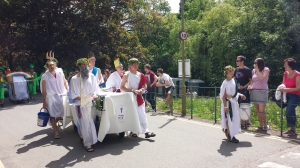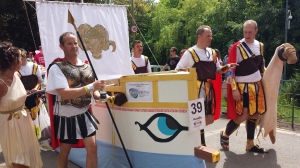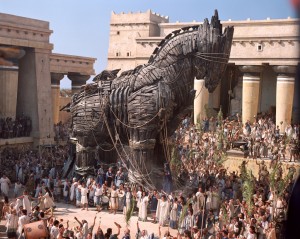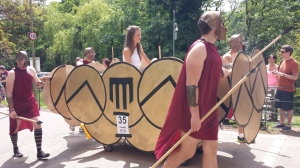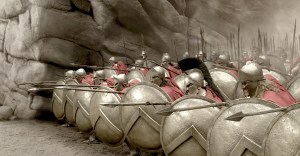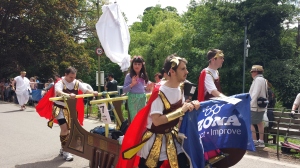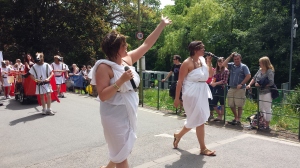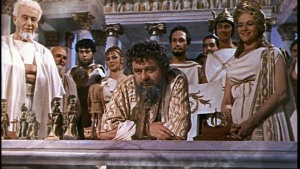Last Saturday I met up with some friends in Knaresborough to watch the 48th annual Great Bed Race. This is the type of utterly mad local event which small English communities seem to specialise in, and it involves teams of six runners pushing a passenger around the town on what is called a ‘bed’, but is really more like a sort of wheeled trolley.
The course starts out in a lovely park by the river, and this was where we sat on a grassy bank in glorious sunshine drinking beer and eating burgers and candy-floss. As the teams ran past us, the terrain was relatively level, but they soon had to slog up a steep slope through the town, along the High Street and back down the valley again, before finally plunging into the River Nidd (trolley, passenger and all) to swim along for several metres pulling the trolley, before hauling it out again onto the opposite bank and reaching the finishing line. The race rules, of which we were handed a copy when we arrived, state:
“Each bed must have a built-in buoyancy aid capable of supporting the bed and the passenger for not less than five minutes, and have an aperture large enough to allow the passenger to escape quickly if required.”
And well they might!
All of that is entertaining enough, but for extra fun the teams also take part in a parade before the race begins. For this, they decorate their beds and dress up themselves according to a theme, which this year was ‘Myths & Legends’. We got a great view of this from our bank in the park, with all sorts of imaginative tableaux parading past us involving the Loch Ness Monster, leprechauns, fairies, the Knights of the Round Table, vampires, Roswell / Area 51, various sporting legends, pirates, samurai warriors and so forth.
What really made my day, though, was the fact that out of 91 teams in total, fifteen had drawn their inspiration from the myths and legends of the Classical world. That’s nearly one in six, maths fans – and a great testament to how important Classical stories still are in the imaginative landscape of modern Britain. So I leapt into action with my phone-camera, and managed to capture pretty decent images of every single one of these teams. The photographs follow below, grouped roughly according to when the legends which they depict were supposed to have taken place, and accompanied by some comments on what I think the teams’ choices tell us about how Classical stories are perceived today, and how people tend to learn about them.
Older than time itself, of course, are the gods. Two teams went with this theme, as follows (click on either picture for a closer look):
I can’t be certain whether either team was thinking of the Greek or the Roman pantheon, though my guess would be Greek. Certainly, most of the teams in this race were drawing on Greek rather than Roman myths, and I’ll say a bit more about why later. Also, the racing context may well have encouraged people to think about the Olympic games, Mount Olympus itself and hence the (Greek) Olympic gods. But in any case, both sets of gods map very closely onto one another. On the left-hand team I can identify Zeus / Jupiter (beard and thunderbolt), Poseidon / Neptune (tripod) and Helios / Sol (radiate crown), but I must admit I’m stumped by the fellow in what looks like a yellow Christmas hat and the round-topped sceptre held by the young person carrying the charity collection bucket. Two more team-members just seem to be wearing generic togas / chitons and laurel wreaths. Perhaps they are meant to be Olympic victors?
The right-hand team have gone to the trouble of spraying themselves gold – a great way to signify divine status, which was done with literal gold-plating on ancient statues, and I think is also what the glowing CGI appearance of the Greek gods in the 2010 version of the film Clash of the Titans was trying to achieve. They have built a model of Zeus / Jupiter with his thunderbolt in front of the temple, and although I am not sure about the lion face on the front of the trolley, I wonder if it is meant to go alongside the red dragon-looking face on the far side and the possibly-a-snake on the near side to make up some kind of Chimera? If so, we are definitely in the Greek world. Meanwhile, amongst the team I can see Mercury at the back with his winged helmet and staff, and assume the fellow with the inflatable globe is Atlas (strictly a Titan rather than a god, but near enough). But the other person at the front doesn’t have any identifying attributes, and already I can’t remember what the fourth person who must be at the far corner looked like.
Next on the mythological schedule is the winged horse Pegasus. In ancient literature, Pegasus is associated with both Bellerophon and (later) Perseus, but both of these heroes belong to roughly the same era in the fictional world of Greek mythology – a time before both the Labours of Hercules and the Trojan war.
The wings on the first horse aren’t as obvious as the others, but they are there, represented by feathers along the side of the trolley. The second horse has a young lady in a fairy-princess costume riding inside it, while the close-up of the third horse in the final picture shows beautiful decorative details in rainbow colours and glitter. I think there is a definite note of magical fairy-lands about these latter two pegasi, reflecting the way that winged horses have found their way into all sorts of post-Classical fantasy stories – these days especially My Little Pony. But the overall aesthetic of all three teams is definitely Classical. Besides, the worlds of magical princesses and the Classical Pegasus were memorably brought together by Ray Harryhausen and Desmond Davis in the 1981 version of Clash of the Titans, what with its distinctly magical fairy-princess version of Andromeda being rescued by Perseus astride Pegasus. So I think these teams are picking up on that merged heritage.
Next comes the hydra, defeated by Hercules as one of his Labours:
The hydra was a terrible creature with multiple heads, all alive and moving independently, and I love the way this has been captured by the model. Some of the heads are static, others are on sticks allowing them to be moved around by the team, while several of the team-mates also wear caps with the same monster-head design, all adding to the impression of lots and lots of horrible scary heads moving around and trying to eat you! And if you look carefully just behind the head of the girl carrying the charity bucket, you will see that one of them has obviously been successful – there is a trouser-leg with a shoes hanging from the end of it dangling from its jaws. Brilliant!
The hydra crops up in lots of modern tellings of the Hercules story, such as Disney’s Hercules (1997), and we’ll doubtless be hearing a lot about it at the conference on receptions of Hercules which my colleague Emma Stafford is running later this month. But Ray Harryhausen and Don Chaffey also added it to the story of Jason and the Argonauts – which brings me neatly on to the next two teams:
The designs here are quite different. The first team has referenced the Jason story directly by including the golden ram’s head on their ship’s sail. I presume the fellow with the breast-plate and shield is Jason himself, apparently on his return journey since one of his team-mates can be seen holding the fabled golden fleece. The second team have gone for more of a sirens theme, shown in the costumes of the runners and a large stuffed mermaid figure on their ship’s stern (of which only the tail is visible in my picture). But their design scheme too is definitely Greek, and what makes me think above all that they are referencing the story of Jason and the Argonauts is the big blue eye on the front of their ship, which the first team have also included on theirs. In fact, of course, this appears on the Argo in the iconic modern telling of the Jason myth – Ray Harryhausen / Don Chaffey’s Jason and the Argonauts (1963):
So between these ships and the fairy-land Pegasi, Ray Harryhausen’s vision of Classical mythology has clearly had a pretty bit influence on these teams – a real tribute to the enduring power of his films which I have also discussed elsewhere on this blog.
Moving a little further forward in mythological time, we enter the period of the Trojan war and its great hero, Achilles, who was immune to weapons over his whole body except for one heel:
These people are osteopaths whose trolley proclaims that they don’t just treat backs – presumably, Achilles’ tendons are on the agenda too. A clever move from them to use the mythological reference in promoting their business, and a good example of how Classical references are transmitted through our culture. According to Wikipedia, the practice of describing the tendon at the back of the human foot with reference the story of Achilles grew up amongst anatomists in the early modern period (it’s recorded as an established practice in 1693). This was a time when learned people were well-steeped in Classical texts – in fact, anatomists were still making substantial use of ancient medical writers like Galen and Hippocrates. So it’s not surprising that they reached for Classical stories like the Achilles legend to name human body-parts. Now that name has stuck, and it helps in turn to keep the story alive. I’m sure many people now hear of an Achilles tendon before they know the story behind it, and I hope it inspires some people to discover the story itself.
After the death of Achilles, the Greeks finally turned the war in their favour by building the Trojan horse, filling it with soldiers, and leaving the unsuspecting Trojans to drag it inside their city walls. Two teams had a go at making their own version:
I am not sure you could fit very many soldiers inside the first horse, but the second one is pretty epic! To my eye, it also looks quite similar to the horse featured in Wolfgang Petersen’s Troy (2004):
They’re not exactly the same, for sure – the Petersen one has a much ‘rougher’ look, capturing the feel of something cobbled together out of bits of broken-up ships. But there’s something about the use of individual planks of wood in this horse, as opposed to smooth panels like the other one, which gives it a similar feel.
Moving out of the realms of outright myths and into recorded history (which can still generate stories of legendary heroism, of course) it’s time to meet the Spartans:
I think the combination of the shield designs, the helmets and the scanty tunics make it pretty clear that we are not just meeting any old Spartans here, but specifically the ones envisaged in Zack Snyder’s 300 (2007):
So we’ve now seen designs which are quite definitely influenced by 300 and Jason and the Argonauts, and probably also others influenced a little more indirectly by Clash of the Titans and Troy. Most Classicists today are already very well aware that one of the main routes by which non-specialists come into contact with Classical stories today is film and TV – indeed, my survey of which Roman emperors people in Leeds were familiar with showed much the same thing. But I think the choices made by these teams are one more proof of that, if anyone needs it.
Finally, we’ve not heard much from the Romans yet. That’s no big surprise. As Gideon Nisbet has shown, Greek mythology is big news in popular culture today, whereas the modern image of the Roman world is all about marching legions and gladiatorial games. So when people are dressing up to a ‘myths and legends’ theme, of course Greek stories are going to predominate. Nonetheless, three teams did lean in a Roman direction:
To be fair, this ship is quite multi-cultural. The overall design could be Greek or Roman, and alhough they’re not visible in this picture, it also had some quite Celtic-looking designs on the prow. If I could identify the picture of the female head on the stern, I might be clearer about where this team got their inspiration – but although I’m sure I’ve seen it before, I can’t pin it down now.
These two are definitely Roman, though. The lady in the first chariot is clearly Boudicca, because she had the famous knives on her chariot wheels (not visible in the picture above, but see below right behind the two singers). I’m not so sure about the second lot – perhaps they were thinking of Boudicca too (especially since they are an all-female team), but decided to omit the knives? Or perhaps it’s a more general reference to Roman chariot-racing as seen in films such as Ben Hur? In any case, the net result is that the only identifiable story from the Roman period represented at the bed race was the story of Boudicca, who of course crucially wasn’t a Roman at all, and indeed stands in the popular imagination as a symbol of Celtic resistance to Roman imperialism. The many myths and legends which the Romans did actually have continue to languish in obscurity today, just as Wiseman has discussed.
For the sake of completeness, I should add that there was also a Roman rock band in the middle of the parade, featuring three dudes on guitars and drums in the back of a van, followed by two ladies on foot singing:
Obviously they weren’t referencing any particular myth, but I’m sure their performances are legendary…
I’ll finish by saying that although I have concentrated on the Classically-themed teams here, because that’s my area of interest, the whole parade was brilliant, and the race itself was a thing to behold! There is a great video of this year’s race here, which shows some of the other teams and really captures the experience of the day as a whole, and I can really recommend going along to experience it for yourself if you get the chance:


